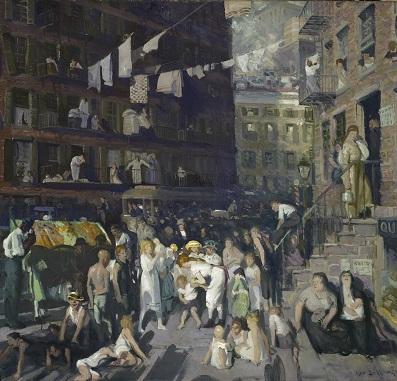Last week I traveled to New York for a few days—my first time back in many years. I lived in New York for half a decade in the early aughts, though I always knew my time there would be limited. Like many people I had a love/hate relationship with the city. One need only walk a few blocks in New York to become inspired by its energy and ambition. One need only walk those blocks for many months or years for that inspiration to feel more like an infection—energy and ambition become din and bustle. Eventually it got to me and I finally decided it was time to come to California, where I find life to be vibrant but with less anxiety (or, at least, a different kind of anxiety). Of course, returning to New York after so long away had me feeling nostalgic; the city tempted me to fall in love with it again. I almost did.
While in the city I visited the Metropolitan Museum of Art, where George Bellows is on view through February 18. It's a beautiful show that ably shows Bellows to be a master of his medium and a superb documentarian of New York in the early twentieth century.
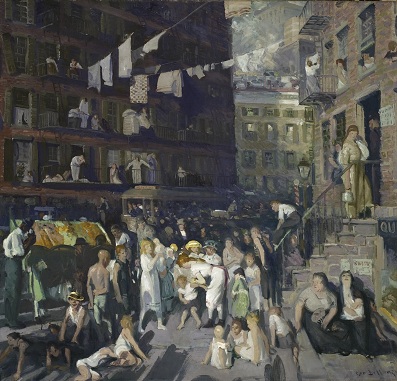 George Bellows, Cliff Dwellers, 1913, Los Angeles County Fund
George Bellows, Cliff Dwellers, 1913, Los Angeles County Fund
Amid the numerous paintings and drawings in the show are a couple of familiar works from LACMA’s collection: Emma in the Purple Dress (1919) and Cliff Dwellers (1913), as well as an early drawing that anticipated Cliff Dwellers. (Fun fact: Cliff Dwellers was the very first work of art acquired by the museum, in 1916, when our budding collection was part of the Los Angeles County Museum of Science, History, and Art in Exposition Park.) Cliff Dwellers is undoubtedly one of the masterworks of LACMA's collection, though I admit that on a personal level I sometimes feel a desire to get away from it.
To Bellows’s credit, I guess, the painting stirs in me all the feelings about the crowded city that made me want to leave. The close quarters, the darkness in daytime, the noise of children and transit, the odor of labor. Above all else Cliff Dwellers is evocative! And there in the Met's galleries, where I had just stepped in from the city streets, perhaps even more so. It benefited from being surrounded by other Bellows scenes, as well as from my journey from downtown via the 6 train. I had two thoughts when I saw the painting in the exhibition: "god, what a fantastic painting," followed quickly by "god, I'm glad I live in Los Angeles."
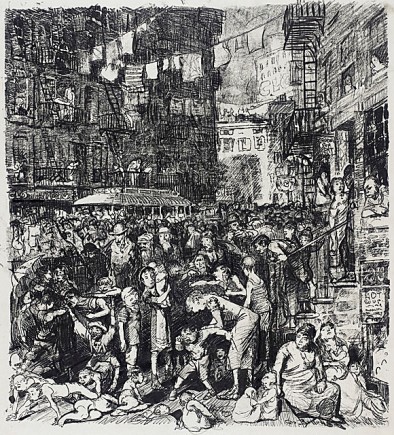 George Bellows, Why Don’t They Go to the Country for Vacation?, 1913, Los Angeles County Fund
George Bellows, Why Don’t They Go to the Country for Vacation?, 1913, Los Angeles County Fund
When installed in LACMA’s galleries, Cliff Dwellers is sometimes paired with another prize painting, Millard Sheets' Angel's Flight (1931), which is a similar scene—a crowded downtown vignette. The two paintings of a similar style and feel, depicting New York and L.A., are a natural pair. In fact it’s quite possible that the L.A.-based Sheets, who likely visited the County Museum and saw Cliff Dwellers prominently displayed, was inspired by Bellows’s painting. And yet to me the pairing has always felt like an unnatural juxtaposition.
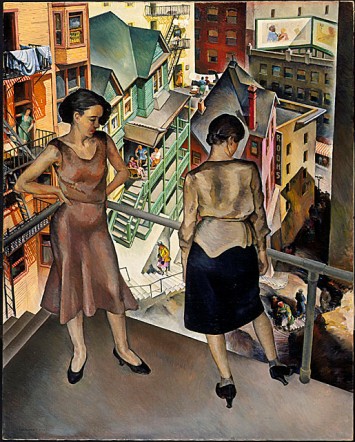 Millard Sheets, Angel’s Flight, 1931, gift of Mrs. L. M. Maitland
Millard Sheets, Angel’s Flight, 1931, gift of Mrs. L. M. Maitland
Of course I can’t say that from an academic perspective—the composition and subject matter invite contrast. It’s not about what the paintings present to me; it’s what I’m projecting onto the paintings. When I think of the two images in simplistic terms—“that’s New York and this is Los Angeles”—the Sheets painting doesn’t evoke my experience of the L.A. the way the Bellows does for New York. Certainly L.A. has its urban center as depicted by Sheets. And, yes, it’s also got some horrendous freeways. If you like you could claim Chris Burden’s Metropolis II as the definitive artwork to evoke that L.A. experience.
For me it’s not the freeways that define this city though. No one falls in love with Los Angeles for its freeways. No, it’s the light. It’s the air. That is why Los Angeles is a beautiful place.
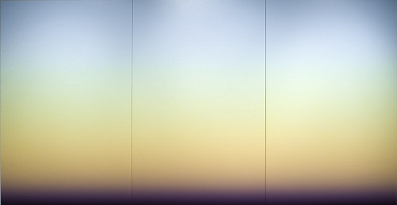 Norman Zammitt, Untitled, 1984, gift of William J. and Marilyn Lasarow
Norman Zammitt, Untitled, 1984, gift of William J. and Marilyn Lasarow
One of the first exhibitions to go on view after I started working at LACMA some time ago was called SoCal, which drew mostly from LACMA's collection and anticipated the kind of content many saw in last year's various Pacific Standard Time exhibitions. Bookending the exhibition were two paintings by Norman Zammitt. I’d found my “Los Angeles” painting. This was how L.A. made me feel. It was big, light, beautiful, soft, expansive, open, awesome. It was a vista, inviting me to look.
Scott Tennent



